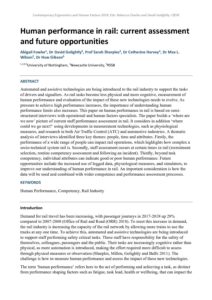| Document | Author Abigail Fowler, Dr David Golightly, Prof Sarah Sharples, Dr Catherine Harvey, Dr Max L. Wilson, Dr Huw Gibson |
| Abstract Automated and assistive technologies are being introduced to the rail industry to support the tasks of drivers and signallers. As rail tasks become less physical and more cognitive, measurement of human performance and evaluation of the impact of these new technologies needs to evolve. As pressure to achieve high performance increases, the importance of understanding human performance limits also increases. This paper on human performance in rail is based on semi-structured interviews with operational and human factors specialists. The paper builds a ‘where are we now’ picture of current staff performance assessment in rail. It considers in addition ‘where could we go next?’ using developments in measurement technologies, such as physiological measures, and research in both Air Traffic Control (ATC) and automotive industries. A thematic analysis of interviews identified three key themes: people, time and attributes. Firstly, the performance of a wide range of people can impact rail operations, which highlights how complex a socio-technical system rail is. Secondly, staff assessment occurs at certain times in rail (recruitment selection, routine competency assessment and following an incident). Thirdly, beyond task competency, individual attributes can indicate good or poor human performance. Future opportunities include the increased use of logged data, physiological measures, and simulators, to improve our understanding of human performance in rail. An important consideration is how the data will be used and combined with wider competence and performance assessment processes. |

